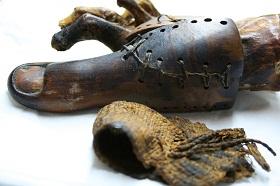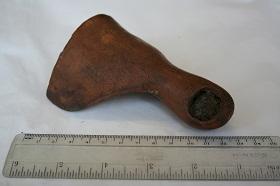Using AI to control energy for indoor agriculture
30 September 2024
Published online 18 November 2012
Ancient Egyptian embalmers may have adorned mummies to preserve an image of bodily completeness, but two artificial toes appear to have served a purpose, making them the earliest prosthetics.

The world's first prosthetic may have been a big toe that helped its wearer walk around ancient Egypt, according to a study.
"The earliest practitioner (although unwittingly) of this branch of medical science may have indeed been a craftsman living in the Nile Valley between 950 and 710 BC," says Jacqueline Finch, an Egyptologist at the University of Manchester in the UK and lead author of the studies paper.
Finch and her team studied two artificial toes discovered in the necropolis of Thebes, the first in the late 19th century and the second in 2000. She tested replicas of the toes on volunteers to determine whether they served a functional or merely aesthetic purpose, publishing her results in the October issue of the Journal of Prosthetics and Orthotics.
The first artificial toe — the Greville Chester toe housed at the British Museum — is estimated to date back to before 600 BC. It is made of cartonnage, a composite material of linen, plaster and glue, shaped into a right big toe and a portion of the right foot.
The other is a three-part wood and leather contraption found on the mummy of Tabaketenmut, a priest's daughter found buried near the city of Luxor. It is housed at the Egyptian Museum in Cairo and dates back to between 950 and 710 BC. The two toes predate the Roman Capua prosthetic leg, made around 300 BC, which was previously thought to be the earliest known prosthetic. While examples abound of restored body parts among Egyptian mummies, with false eyes, noses, genitals and even limbs fitted to mummies, Finch believes these two toes served a functional purpose.
"Completion of the body prior to burial alludes to the myth of Osiris, but generally these additions are crudely made and poorly constructed," says Finch. "The two restored toes that I studied in this research are beautifully fashioned with a real eye to anatomical detail."
The toes' wear and tear suggests they were used in daily life. The toes; smooth edges, designed to prevent friction with adjacent toes, convinced Finch that such features would not have been needed for solely burial purposes.
The mummy's foot also shows that the stump is well-healed, suggesting that the loss of the toe occurred long before death.

J.L. Finch with kind permission of the British Museum, London, UK
To test the likelihood of the toes' use as prosthetics, two volunteers missing the appropriate digit tried on replicas of the artefacts along with ancient Egyptian-style sandals.
"The data from both replicas demonstrated a very satisfactory level when worn with an Egyptian-style sandal," explains Finch. "When the volunteers wore sandals without the toe prosthesis, significant differences in peak pressures were recorded."
This suggests walking in Egyptian sandals without the prosthetic toes must have been uncomfortable.
The two volunteers' walking improved when they wore the replicas, but the Greville Chester toe performed slightly better. The volunteers, however, found the three-part wood and leather toe by far the more comfortable and convincing prosthesis.
Wael Hassane, a physiotherapist at Widener University, Pennsylvania, argues that the prosthetic toes could not have worked in daily life since missing toes do not provide a stump to latch the prosthetics on.
"I am leaning towards the possibility that this lady was an elite and that she wore it for short periods during social activities or indoor gatherings for cosmetic reasons," he says.
Hassane argues that a larger sample of volunteers would improve the results of the study. He suggests that the volunteers should be made to wear the replicas for long periods while going about their daily life and tested on uneven terrains to make sure they served a functional role.
doi:10.1038/nmiddleeast.2012.161
Stay connected: